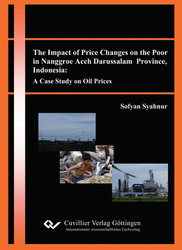| Departments | |
|---|---|
| Book Series (96) |
1378
|
| Nachhaltigkeit |
3
|
| Gesundheitswesen |
1
|
| Humanities |
2363
|
| Natural Sciences |
5406
|
| Mathematics | 229 |
| Informatics | 319 |
| Physics | 980 |
| Chemistry | 1363 |
| Geosciences | 131 |
| Human medicine | 243 |
| Stomatology | 10 |
| Veterinary medicine | 108 |
| Pharmacy | 147 |
| Biology | 835 |
| Biochemistry, molecular biology, gene technology | 121 |
| Biophysics | 25 |
| Domestic and nutritional science | 45 |
| Agricultural science | 1004 |
| Forest science | 201 |
| Horticultural science | 20 |
| Environmental research, ecology and landscape conservation | 148 |
| Engineering |
1791
|
| Common |
98
|
|
Leitlinien Unfallchirurgie
5. Auflage bestellen |
|
Advanced Search
The Impact of Price Changes on the Poor in Nanggroe Aceh Darussalam Province, Indonesia: A Case Study on Oil Prices (English shop)
Sofyan Syahnur (Author)The phenomenon of oil prices increase due to oil subsidy reduction is a crucial and dilemmatic issue for developing countries such as Indonesia. This is because the magnitude of the resulting effects of rising oil prices is not merely related to the shrinkage of the government expenditure burden in the future, but also triggers off a set
of negative consequences on all aspects of economic sectors. Moreover, it also directly or
indirectly engenders a tricky situation on socio-economic households in term of welfarereducing both in rural and urban regions. Most of the theoretical viewpoints are tightly
highlighted that an increase in oil prices will induce elevated living cost for certain
household groups in the society (the living standards of both poor and vulnerable household groups mostly at middle income households fall down). It implies that the impact of oil prices increase will concurrently push the inflation rate to a higher and
higher level (spiral inflation), the purchasing power of households as indicated by the rate of households’ real income worsens in the near future below a certain threshold (poverty
line). At long last those with little income will be trapped into the poverty circle (vicious
circle of oil prices increase). The households are openly vulnerable to be trapped into
poverty and the poor who are already in the poverty trap will be the poorest (chronic
poverty). There is an unambiguous relationship between oil prices increase as one of the
urgent government policies and the households’ real income decline. This study attempts
to investigate the impact of oil prices increase on the poor at regional level in particular in
Nanggroe Aceh Darussalam (NAD) province. To get an in-depth understanding of this
issue, the study utilizes three approaches to capture the micro and macro impact of oil
prices increase on the poor: the Descriptive Analysis Approach (DAA) supported by the
primary data from field research, the Social Accounting Matrix (SAM) approach as well
as the Computable General Equilibrium (CGE) model by comparing two periods of SAM
data (2002 and 2005). It is also important to underline that the oil prices will be more
focused on this study is solely three types of oil prices: gasoline, diesel, and kerosene
prices.
Four specific conclusions of the study are as follows: (1) The main socio-economic
characteristics of the poor being vulnerable to the oil prices increase are greater
household size, profession as a farmer, lower education, and unskilled labor (2)
Government’s action to reduce subsidy on oil will generate oil stock scarcity which picks
up the pace of the oil prices in the community exceeding the government oil price
declaration throughout the scarcity; (3) The oil prices increase highly leads to inequality
in income distribution across institutions as indicated by the different accounting
multiplier and the real income alteration of institution, particularly rural and urban
households which is caused by larger indirect effect than direct effect. (4) In general, the
depressing shock of the oil prices increase highly affects real income of all household
groups in urban areas, but at the end of the impact process it will be negatively
experienced by the households in rural areas through higher inflation rate, especially the
poorest and poor households. Afterwards, they are openly trapped into chronic poverty.
In addition, rural middle-income households are more vulnerable to poverty than those in
urban areas. Therefore, these are key reasons why the poverty rate in Aceh still remains at
high level every year.
| ISBN-13 (Printausgabe) | 3869550953 |
| ISBN-13 (Hard Copy) | 9783869550954 |
| ISBN-13 (eBook) | 9783736930957 |
| Language | English |
| Page Number | 214 |
| Edition | 1 Aufl. |
| Volume | 0 |
| Publication Place | Göttingen |
| Place of Dissertation | Universität Bonn |
| Publication Date | 2009-08-28 |
| General Categorization | Dissertation |
| Departments |
Agricultural science
|








